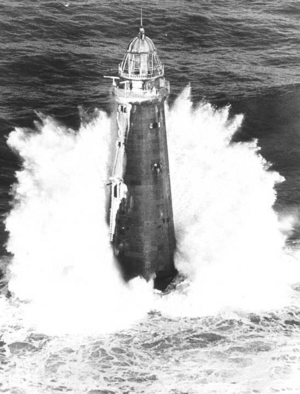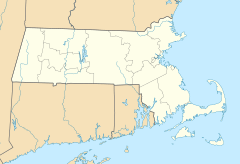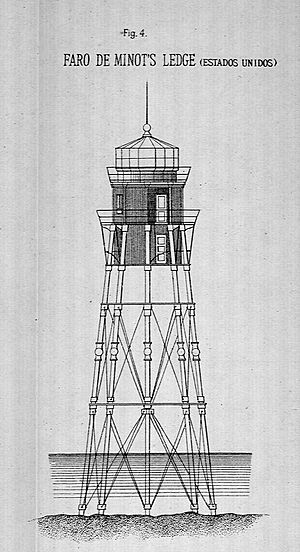Minot's Ledge Light facts for kids
 |
|
| Minots Light in a storm | |
|
|
|
| Location | Offshore Cohasset, Massachusetts |
|---|---|
| Coordinates | 42°16′11″N 70°45′33″W / 42.26971°N 70.75914°W |
| Year first constructed | 1850 (first tower) |
| Year first lit | 1860 (current tower) |
| Automated | 1947 |
| Deactivated | 1851-1860 |
| Foundation | Stone ledge |
| Construction | Granite |
| Tower shape | Conical |
| Height | 87 feet (27 m) |
| Focal height | 85 feet (26 m) |
| Original lens | 3rd order Fresnel lens |
| Current lens | 300 millimetres (12 in) |
| Range | 10 nmi (19 km; 12 mi) |
| Characteristic | Flashing white (1+4+3) 45s |
| Fog signal | Horn: 1 every 10s |
| Admiralty number | J0360 |
| ARLHS number | USA-502 |
| USCG number | 1-440 |
Minot's Ledge Light, also known as Minots Ledge Light, is a famous lighthouse located about one mile off the coast of Cohasset and Scituate, Massachusetts. It stands southeast of Boston Harbor and is part of Cohasset in Norfolk County. This lighthouse is actually the second one built at this spot. The first one was destroyed by a powerful storm only a few months after it was finished.
Contents
The First Lighthouse: A Tragic Start
Minots Ledge was a very dangerous place for ships. Between 1832 and 1841, over 40 ships crashed into the ledge, causing many deaths and a lot of damage. One sad event was in October 1849, when the ship "St John" sank. All 99 Irish immigrants on board drowned, even though they were close to their new home.
Because of these dangers, people wanted a lighthouse. In 1843, an inspector named I. W. P. Lewis said a lighthouse was badly needed. Captain William H. Swift, who was in charge of planning, decided to build an "iron pile light." This was a unique structure made of iron poles drilled into the rock.
Construction of the first lighthouse began in 1847 and finished in 1850. It was first lit on January 1, 1850. However, a huge storm hit the Boston area in April 1851. The next day, only a few bent iron poles were left on the rock. The two lighthouse keepers who were on duty had died during the storm.
The Current Lighthouse: Built to Last
After the first lighthouse was destroyed, a new, stronger design was needed. Joseph G. Totten, a Chief Engineer, took charge of the project. He had a lot of experience building strong structures like forts.
Totten designed the new lighthouse to be incredibly sturdy. The first 40 feet of the lighthouse would be a solid base made of thousands of tons of granite. To make sure it stayed put, huge iron pins were used to anchor the lighthouse to the ledge.
Building this lighthouse was very difficult. Workers could only work when the tide was low and the sea was calm. This meant construction took many years. Work started in 1855, and the lighthouse was finally completed and lit on November 15, 1860. It cost $300,000, making it the most expensive lighthouse built in the United States at that time.
The lighthouse is made of large, heavy granite blocks. These blocks were carefully cut on shore in Quincy, Massachusetts, and then brought to the ledge by ship. The lighthouse also has a special lens called a Fresnel lens to make its light bright and clear.
The "I LOVE YOU" Light Signal
In 1894, the lighthouse got a new light signal. It flashes in a pattern of 1-4-3. People nearby soon realized that these numbers match the number of letters in the words "I love you." Because of this, the Minots Ledge Light is often called the "Lover's Light" by romantic couples.
The lighthouse was made automatic in 1947. This means it no longer needed keepers living there all the time.
History and Construction Details
Minots Ledge was a very dangerous area for ships. Between 1817 and 1847, it's estimated that 40 lives and $364,000 in property were lost in shipwrecks near Minots Ledge.
Building the First Iron Lighthouse
Construction of the first iron lighthouse began in the spring of 1847. The ledge was only about 20 feet wide and was dry for just 2 or 3 hours a day at low tide. Workers had to stay on a schooner nearby and only work on very calm days.
They drilled nine large holes into the solid rock, each 12 inches wide and 5 feet deep. Eight holes were in a circle, and one was in the center. Iron poles, 10 inches wide, were then cemented into these holes. Storms caused problems, sweeping away equipment in the summer of 1847. Workers were even swept into the sea, but luckily no one drowned.
By September 1848, the iron poles were in place. A heavy cast-iron top, weighing 5 tons, was attached to the poles. The keeper's living area was built on top of this, and then a lantern room with a Fresnel lantern was added. The light was first lit on January 1, 1850.
The first keeper, Isaac Dunham, worried the structure wasn't safe and asked for it to be strengthened. When nothing happened, he quit. The next keeper, Captain John W. Bennett, at first didn't believe the fears. But a terrible storm soon changed his mind, and he reported the tower was in danger.
During a severe storm on March 16, 1851, the keepers had to hide in a lower storeroom for four days. The tower swayed violently. On April 17, 1851, just before 1 a.m., the central support of the lighthouse snapped. The heavy lantern tower then plunged into the ocean. The two assistant keepers, Joseph Wilson and Joseph Antoine, died.
Building the Second Granite Lighthouse
After the first lighthouse was lost, a temporary lightship guarded Minots Ledge from 1851 to 1860. Plans for a new stone lighthouse were made by Joseph G. Totten, and Barton S. Alexander started construction in April 1855.
The ledge had to be cut down to fit the foundation stones. The old iron stumps from the first tower were removed. The granite blocks were cut and put together on Government Island in Cohasset before being moved to the ledge.
Work was difficult. A severe storm on January 19, 1857, destroyed the temporary scaffolding. So, in the spring of 1857, they had to start over.
The first stone of the new lighthouse was finally laid on July 9, 1857. They used sandbags to create temporary barriers so the foundation blocks could be cemented to the rock. The total cost was about $330,000. By the end of 1859, the lighthouse was 62 feet above low water. The last stone was laid on June 29, 1860. The new lighthouse was finished by mid-August 1860 and officially lit on November 15, 1860.
This new stone tower has been incredibly strong. It has survived every storm since it was built. Even when huge waves sweep over the top of the 97-foot structure, it only experiences minor issues like leaky windows.
On May 1, 1894, the new flashing light pattern (1-4-3) was installed, earning it the nickname "Lover's Light." The light was made automatic in 1947. Today, its bright light can be seen for 15 miles.
Minot's Ledge Lighthouse was added to the National Register of Historic Places in 1987. It was even put up for sale in 2009 under a special act for historic lighthouses.
Names and Location Details
Officially, the lighthouse is called Minots Ledge Light. However, the National Register listing uses the name Minot's Ledge Light. It is located on Scituate Rocks and helps protect Cohasset Harbor.
There is a replica of the top part of the lighthouse on the shores of Cohasset Harbor, near the Cohasset Sailing Club. This replica is actually made from some of the original stone and steel parts of the lighthouse's upper section.
Images for kids
-
The off-duty lightkeeper's house was located in Cohasset.







